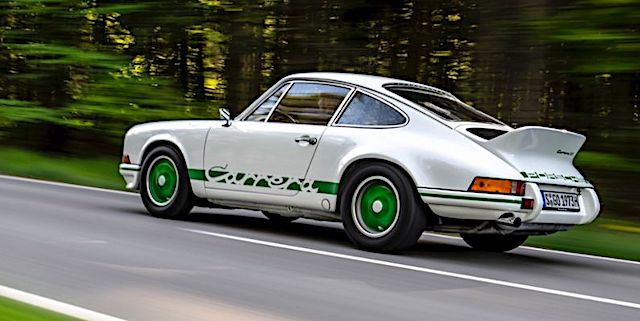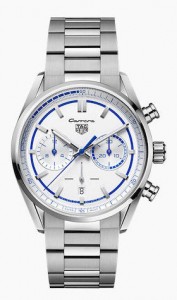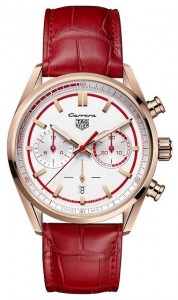
The longtime relationship between performance car brands and prestige watchmakers continues …
Swiss company Tag Heuer has released limited-edition timepieces to mark the 50thbirthday of the ‘duck tail’ Porsche 911 Carrera RS 2.7, perhaps the most celebrated of all road-going Porsche models.
Nicknamed after the brand’s racing success with the 550 Spyder in the Carrera Panamerican rally in the 1950s, the Carrera RS 2.7 brought track dynamics to the street and was the fastest German production car upon its release in 1972. More on it down the page.
Tag Heuer honours the legendary reputation of the Porsche flyer with two chronographs, both available on Tag Heuer’s website (that’s if there are any left).
One is in stainless steel and limited to 500 examples, the other in rose gold and limited to 250. The steel version is priced at US$7750 (NZ$13,840), the gold at US$23,550 (NZ$42,000).
Tag Heuer, a brand known for its own history in motorsport, began a partnership with Porsche last year. The Carrera edition watches, unveiled at a glitzy all-Carrera event in Paris, is the fourth Porsche-themed watch it has released.
Few Porsche models are as iconic as the 911 Carrera RS 2.7 The car came to life after Porsche decided in 1970 to enter the FIA Group 4 GT/Special Sports Car category with a lightweight race car based around the 911 S. To meet homologation requirements, it needed to build 500 road-going examples and ultimately launched the Carrera RS 2.7. The Spanish word Carrera translates as ‘race’ in English; RS is for ‘Rennsport’, or ‘racing’ in German.
 The car was unveiled at the 1972 Paris motor show in Touring and Sport guises. It quickly sold out, prompting Porsche to build more. By the time production had ended a year later, 1525 units had been sold. Of these, 1308 were Touring variants, 200 were lightweight Sport versions, and 17 were RSH (H for homologation) models.
The car was unveiled at the 1972 Paris motor show in Touring and Sport guises. It quickly sold out, prompting Porsche to build more. By the time production had ended a year later, 1525 units had been sold. Of these, 1308 were Touring variants, 200 were lightweight Sport versions, and 17 were RSH (H for homologation) models.
Among the overall total were 117 right-hand drive models. Total production, including prototypes and test mules, ran to 1590. Once the 1000th vehicle rolled off the production line the Carrera RS 2.7 was homologated for Group 3 racing as well as Group 4.
Powering the car is a 2.7-litre naturally aspirated flat-six that produces 154kW at 6300 rpm and 255Nm of torque at 1500 rpm, for a best 0-100km/h sprint time of 5.8 seconds and top speed of 240-245km/h. Gearbox is a five-speed manual.
The body was all about weight reduction. Thin sheet metal, thin windows, plastic parts and the elimination of insulation helped. The interior was pared back to the essentials: among other things, rear seats, carpets, clock, coat hooks and armrests were omitted.
Optional were two lightweight seat shells in place of the heavier sports seats. Even the Porsche crest on the bonnet was initially glued on. Weight ranged from 1075kg for the Touring to 960kg for the Sport. The RSH variants were lighter again.
One of the main aims for Porsche engineers in order to achieve more neutral handling at high speed were aerodynamic modifications to minimise lift on the front and rear axles. Enter the rear spoiler, thereafter effectionately dubbed the ‘duck tail’. It pushed the Carrera RS 2.7 closer to the road and supplied the rear engine with extra cooling air.
The effect was achieved without any increase in drag. In fact, the car’s top speed was boosted by 4.5km/h. Said Peter Falk, Porsche head of testing at the time: “During tests, we found that with a taller spoiler we could increase the top speed due to the decrease in drag. So we kept raising the rear spoiler upward by millimetres with sheet metal at the tear-off edge until we found the reversal point at which the drag increased again.”
Another first for a road-going Porsche were different tyre sizes front and rear, a setup it had used on race cars. To accommodate the wider rear tyres, Porsche widened the body of the Carrera RS 2.7 near the rear wheel arches by 42mm. “When this worked well in development, production and sales, all subsequent models were fitted with this combination,” said Falk.
- Of the 117 right-hook variants, 111 went to the UK and six to Australia. The six were Touring versions and went on sale across the Ditch in 1973 at A$17,000. That same year the Ford Falcon GTHO Phase III retailed at just over A$5000. The 1973 Porsche 911 Carrera RS 2.7 is believed to be the quickest-appreciating vehicle in the past decade. Earlier this year in the US, auction house RM Sotheby’s were listing an early production Sport model at US$1.35 million.

